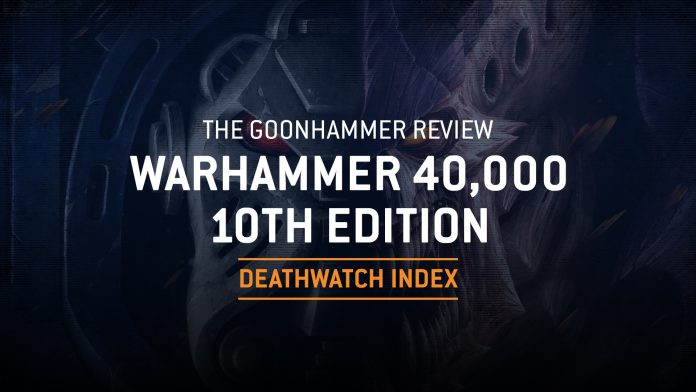Xenos better start quaking in fear – the Deathwatch have arrived, and they’re looking great. Time for us (James “One_Wing” Grover and Shane Watts) to dig in to why.
This review is just of the Index rules and datasheets themselves – so some takes are speculative until we have the Munitorum Field Manual to confirm whether the price is right. This is going to be particularly relevant for Deathwatch because exactly how strong Kill Teams are will depend quite a bit on how they’re priced.
If you’d like to check out any of the rest of the juicy details about 10th Edition, go check out our landing page.
Finally, before we begin we’d like to thank Games Workshop for providing us with a review copy of the Index.
Note (14th June 2023): With admirable haste, Games Workshop have updated the Hellfire Rounds stratagem so that it no longer interacts with Devastating Wounds. This is very likely to be good news for the metagame overall, but does mean that some comments in this review are a bit out of date (though we’ve mostly tried to correct them). We still think Deathwatch look very good without this stratagem – fully tooled-up shooty Proteus Teams are still some of the nastiest things out there, just not quite as capable of flattening half an army in a turn.
Army Rules
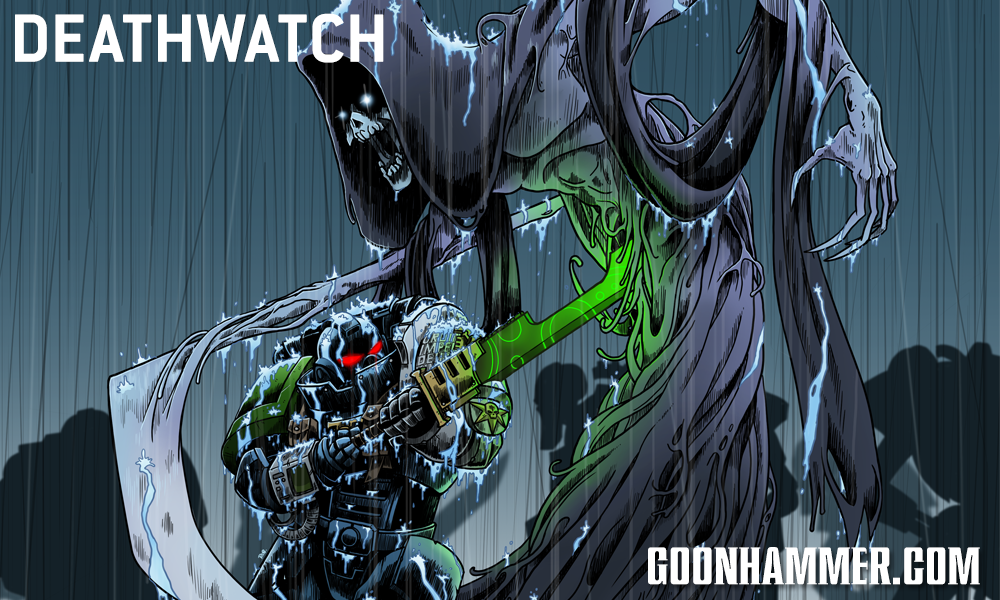
Oaths of Moment
Like all the non-Codex compliant chapters, Deathwatch are still Space Marines, and so gain the Oaths of Moment army rule, allowing them to fully dunk on one target per turn with full Hit and Wound re-rolls. This is very good, and you are not sad to have it.
Kill Teams
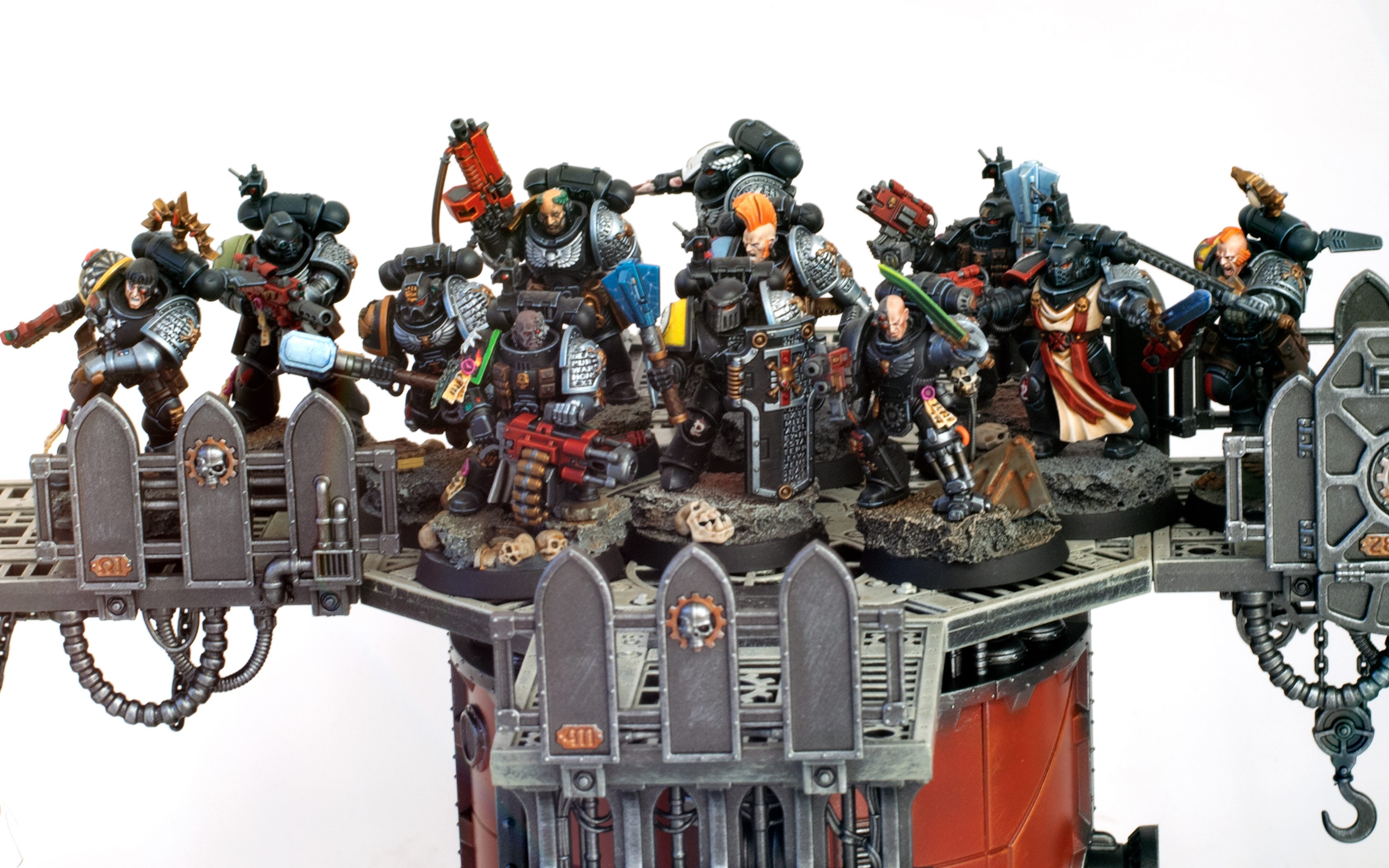
Deathwatch’s signature unit is the Kill Team, an assembly of elite marines that sometimes includes a variety of armour types, and can even add bikers and jump pack units to regular squads. There are some up-front rules to cover how this works.
If you have a unit with mixed toughness values, you use the majority value at the time targets were chosen for a units attacks until those attacks have been fully resolved. This means your opponent is never going to end up having to slow roll in case the majority changes part way through, but does mean that you can sometimes kill off T4 models where the wound rolls were made against T5.
The other place mixed units can get weird is with terrain and transports, and in both cases this is slightly abstracted. Kill Teams ride in transports according to their unit keywords (usually infantry) even if the models within would have keywords like JUMP PACK or TERMINATOR in other units. Such chunky models do count as two models for capacity purposes, but otherwise get to ride. Similarly, all models in a Kill Team interact with terrain as though they were INFANTRY – they teach you some really fancy tricks in Deathwatch bike school.
Finally, while this isn’t part of the rules at the start of the Index, it’s worth calling out now – each Kill Team has a rule on its datasheet that allows any character that could join the equivalent unit that makes up their “core” to join them, so for Proteus anyone who could party with Vanguard Veterans gets in, Heavy Intercessors for Indomitor, etc. This gives you plenty of options to tinker with, and might make Deathwatch a place for some more niche characters to get an extra lease of life.
Detachment Rules – Black Spear Task Force
![]()
Deathwatch can choose to use the standard Gladius Task Force detachment, in which case the datasheets here are on the table, but none of the stratagems and enhancements are. If you want to play a true Deathwatch force, you can swap this out for the Black Spear Task Force detachment, giving a different detachment rule and set of options, plus some restrictions.
Restrictions
Unsurprisingly, if you go this route you can include Deathwatch units, but cannot include units from any other chapter. There’s also a set of datasheets that you don’t have access to, representing units that simply don’t appear in Deathwatch forces. These include Scouts of all kind, the three classic firstborn infantry units and Attack Bikes.
Detachment Ability – Mission Tactics
The Black Spear detachment gives you an ability that’s structured similarly to Combat Doctrines, with three army-wide abilities you can select once per game, but is focused on pure killing power rather than tactical flexibility. You can either select Furor Tactics for horde clearance with Sustained Hits 1, Malleus Tactics to hunt big targets with Lethal Hits and Purgatus Tactics to launch a decapitating strike, giving all your attacks Precision on Critical Hits. All of these are strong effects that combine well with Oaths of Moment, and you do of course get some ways to play around with them in the Stratagems. Wide-ranging Precision is the most unique trick here by far, and potentially lethal to opponents who’ve built around Leaders – such models tend to be a bit squishier in 10th than they used to be, so a whole army getting to start chipping wounds off them is a serious threat. The others are certainly good as well, and you can get extra value by picking the appropriate option to go with whatever you’ve target with Oaths this turn.
Enhancements
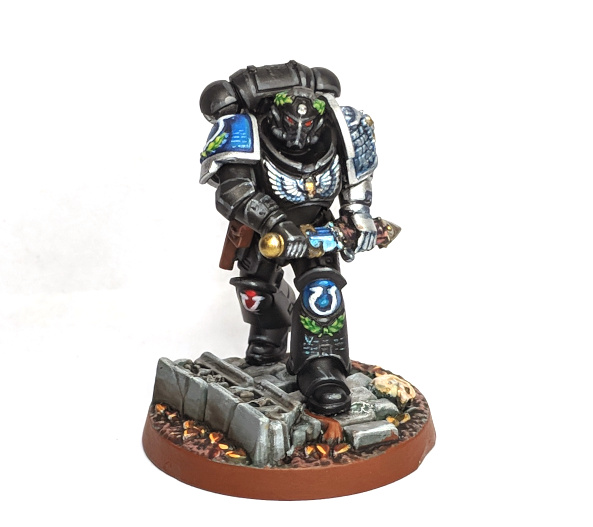
Blackspear Enhancements are great, appreciably better than the Gladius ones and a serious draw to this detachment. Thief of Secrets, to kick off, is a very strong offensive upgrade, giving a Character’s melee weapons +1 to each of Strength, AP and Damage, all of which double to +2 at the end of the first phase where they kill any models in melee. In terms of pure stat boosting, this sits alongside the Heavensfall Blade as the best such upgrade that any Marines get access to (and the condition for upgrading here is more reliable), so if you want to build the murder machine of your dreams this rocks.
Following on from that, we have an extremely unique (for 10th Edition) and potent ability from the Beacon Angelis, which gives the bearer and their unit Deep Strike and a free use of Rapid Ingress. Now that you don’t have pre-game Stratagems, adding full Deep Strike to a unit that doesn’t already have it is extremely rare, and getting a free (powerful) stratagem alongside it is great. Slamming this on the Apothecary Biologis in a full-sized Indomitor Kill Team seems like a slam dunk from the Deathwatch book, but there’s a whole world of horrific things you can cook up with this – very strong.
Another fairly unusual effect comes from the Osseus Key, which is available to Watch Masters or Techmarines (which is fine, you probably want the former). This lets you pick a nearby enemy Vehicle at the start of the opponent’s shooting phase and force a Leadership test on it – if they pass they’re at -1 to hit, and if they fail they cannot shoot at all this turn. That’s clearly a potential game-changer, but it’s situational and unreliable so might end up as a tough sell – it’ll depend a lot on how Vehicle-heavy the metagame ends up being.
Finally, Deathwatch are all about launching a brutal strike at a key moment, and the Tome of the Ectoclades lets them do that – only Captains and Watch Masters can take it, but once per game (as long as they’re on the table) you get to pick two Oaths of Moment targets rather than one, helping push back against a multi-pronged assault from armies like Knights that can field several huge threat. I do not think I need to explain why this is good – it would have to be very expensive to not be worth consideration.
Stratagems
Deathwatch get the standard set of six Stratagems, and like all Marine flavours their first is a straight import – Armour of Contempt. This is very good generally, it’s especially good in a faction that can seed Terminators into a regular squad, good chat, moving on.
The other five are unique to Deathwatch, and all of these lean in to the faction’s special trick of bringing Kill Teams. Each of them applies a powerful effect to a unit, but instead of picking one unit you can pick two Kill Teams, giving you enormous value for your 1CP. That, obviously, incentivises bringing Kill Teams along, and that’s part of why this Index is so hard to fully evaluate without the points – how much do you pay as a premium for a “base” kill team compared to their equivalent unit, and how expensive are the full ones? That’ll have a big impact here – but there is at least some good news in that this genuinely feels like a bonus rather than something you need to be doing for these to be worthwhile – these are outstanding effects.
The first to look at is the extremely unsurprising Adaptive Tactics, which lets a unit (or two KTs) assume a Mission Tactic of your choice instead of the currently active one (if any). Of the five stratagems, this is probably the one you most want to double tap on to make it worth it – the Tactics can be worth it on a single unit, but only if you desperately need something dead (or to try snipe out a Leader).
The rest, however, are more unique and more exciting. Teleportarium lets you pick up a unit (or two KTs) in your opponent’s Fight Phase and Deep Strike them in your coming turn, which is pretty awesome. Extremely valuable to have up your sleeve, good utility.
The remaining three stratagems bring the return of the Deathwatch’s signature special ammunition, providing buffs in the shooting phase. Notably, these aren’t locked to bolt weapons any more, they just affect all guns, which is pretty tremendous. The only catch is that these are mutually exclusive – a unit can only be under the effect of one of them. Doesn’t matter though – they rule, and you absolutely will pay for these even on single units.
The effects available are Hellfire Rounds to add Anti-Infantry 2+ and Anti-Monster 5+, Kraken Rounds for +6” range and +1AP and Dragonfire Rounds for Assault and Ignores Cover. These are all super good – Hellfire lets you annihilate infantry hordes (or, you know, any infantry when combined with Assault Cannons and their Devastating Wounds) [not any more, see note at the start], and punch up into big targets, improved AP is very valuable in an edition where the average is lower (and not that common), and getting to Advance/Shoot in an emergency (plus often pick up the equivalent of +1AP if the opponent is in cover). This is a phenomenal toolbox to have access to, and does also really reward bringing the big Kill Team units that Deathwatch encourages, as you get more value out of them. However, there are plenty of other good targets as well – imagine blowing Hellfire or Kraken on a Repulsor or Gladiator Reaper? Or, in fact, the extra dense array of heavy weapons that Deathwatch Terminators can bring? The only real requirement for access to these to be great is that you bring some serious shooting units – do that, and you’re good.
Datasheets
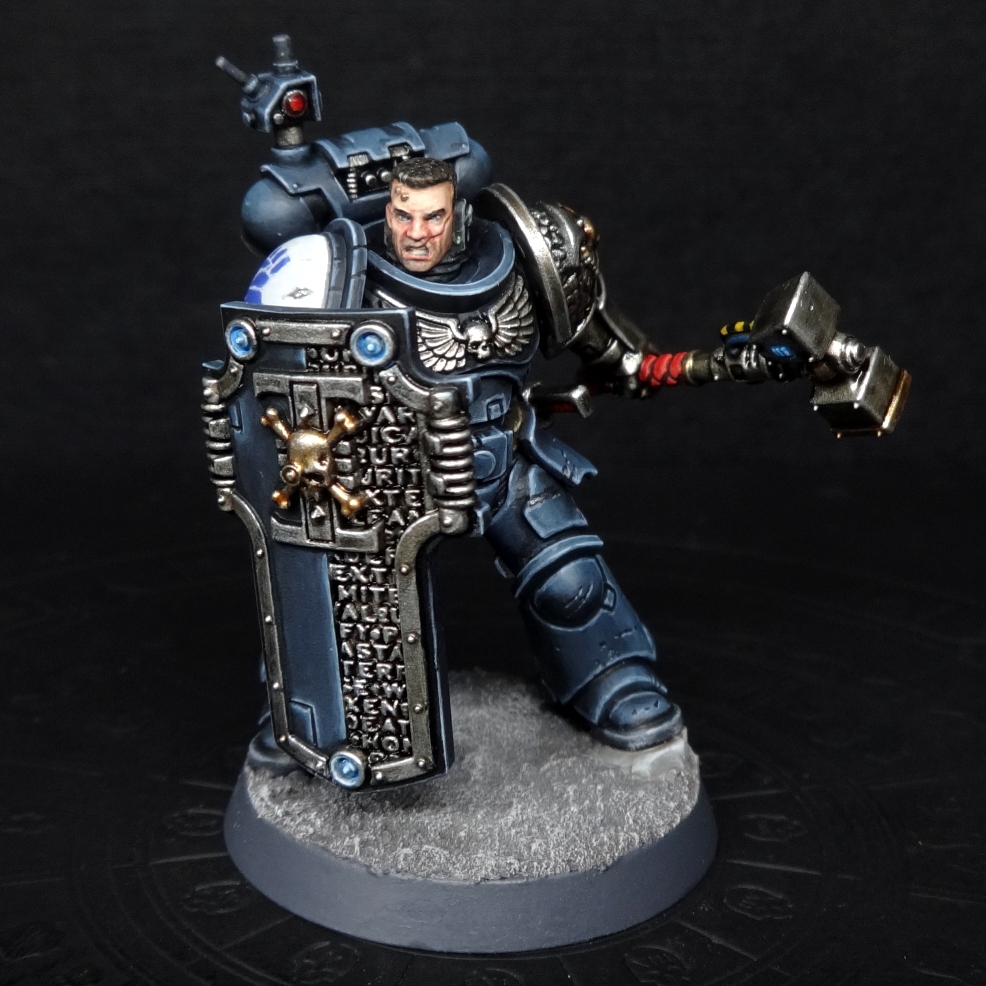
Deathwatch don’t have that many datasheets, but those that they do have are pretty exciting – extra-customisable versions of some core Marine units, then the signature kill teams that provide you with some absolutely stacked blocks of Marine goodness to anchor your army.
There is an important caveat to repeat up front here – more than almost any other unit, Kill Teams are going to live and die on their points costs, and we have no idea how pricing them is going to be handled here. What is certain is that all of them still have to take a minimum of five of the “main” model, and Combat Squads are gone, so you can no longer build half and half of a regular unit and a weird out-there assemblage of specialists then split them. Kill Teams are going to be good if taking a fully operational ten model nightmare is worth the price of entry.
Five Coolest Units
- Deathwatch Veterans: One of the nastiest BATTLELINE options out there, bringing plenty of special toys to the battlefield alongside built-in re-rolls.
- Deathwatch Terminators: All the goodness of the upgraded Terminator statline, but with more wargear options, including three special weapons per five models.
- Proteus Kill Teams: Slam the above together and make one of the most appallingly deadly shooting units around.
- Indomitor Kill Teams: C H O N K
- Watch Captain Artemis: Is kind of cool now, which compared to the last few editions counts as an enormous win!
(Spectrus Kill Teams also rule, but I put together this review template and made everyone else comply with it, so I’ll get in trouble if I break it).
Five Biggest changes from 9th
- Big Shooty Kill Teams: in 9th, big Kill Teams mostly did melee and shooting was mostly delegated to things like Dreadnoughts. Proteus Kill Teams can now be stacked with a staggering amount of firepower, making them the tool of choice for this.
- No Aura-based Battle Piles: One of the better things you could do with Deathwatch in 9th was stack up a bunch of Dreadnoughts and Veterans around the Dominus Aegis and some powerful auras. 10th does not support this at all – get out there and hit them hard.
- Excellent Pivot Potential: Deathwatch had a bit of this before with the old version of the Beacon Angelis, but the new version of Teleportarium plus Spectrus Teams having built-in repositioning allows the army to really turn on a dime at a key moment.
- No more combi-weapon shenanigans: Veterans are a great unit, but the days of working out how you could best break them to hell with combi-weapons are over – they can take them, but with the flattened 10th version of them there’s no real reason to. Luckily, the assault cannon fills pretty much every role this ever did at once.
- Character Fun: Kill Teams unlock some additional stomping grounds for some niche character options, and coming up with surprise combos should be great fun for listbuilders.
Characters
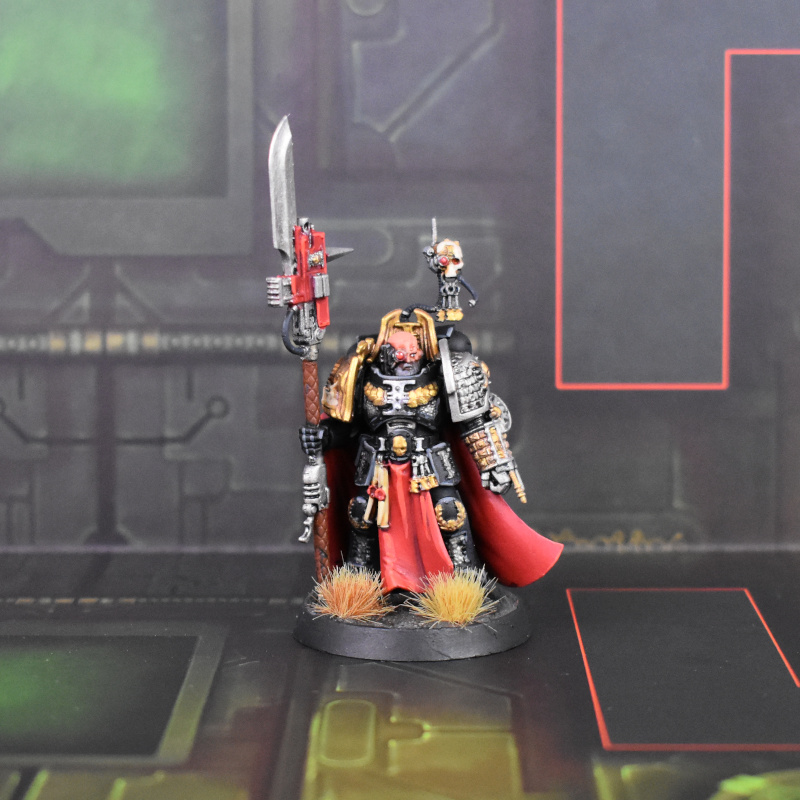
Deathwatch get two unique characters to play with – the Watch Master and Watch Captain Artemis, both of whom can join up with Deathwatch Veterans or Proteus Teams.
The Watch Master seems like a fantastic add to a Proteus Team, providing them with incredible flexibility (Shoot and Charge after Advancing or Falling Back) and adding some substantial extra melee heft with his vigil spear – six attacks at S6 with Lance is no joke. He also provides you with access to a once-per-game Vect-style ability to increase the CP cost of future uses of an opponent’s stratagem (as long as he’s your warlord), which is an extremely powerful effect in a low CP world, particularly as it can hit Command Re-roll. Proteus Teams looks like you’re going to want to mostly build them for shooting, but they’re going to end up with a bunch of melee punch too thanks to Terminators, and adding this guy in pushes that over the top and creates an incredibly good centrepiece unit.
Watch Captain Artemis also has some cool things going for him now. First among them is his signature combi-weapon Hellfire Extremis, which is now a super flamer with the fairly horrifying combination of Anti-Infantry 4+, Torrent and Devastating Wounds (along with some other improvements over a regular one), letting him chuck out a tasty clip of Mortals. He’s also got an unusual ability where his unit can always be selected as the target of a Stratagem, even if you’ve already used it this phase or the unit is Battle-shocked. Deathwatch Stratagems are great so this is nice to have access to. Finally, he hits hard in melee, and stands up at the end of the phase on a 2+ once per game, ready to hand out a last dose of Hellfire Extremis pain. Not quite as much of an auto-include as the Watch Master, but if you can squeeze it all in then him babysitting your second big Proteus unit seems great.
The only real question with both of these is whether you’re taking them over a humble regular captain in the role – Deathwatch’s absurdly strong strats make access to free uses very, very good, and neither of these two bring that. I’m a bit higher on the Watch Master, while Shane is a big fan of what you can unleash with Artemis – hopefully we’re both kind of right and Deathwatch players get lots of choices!
Regulars
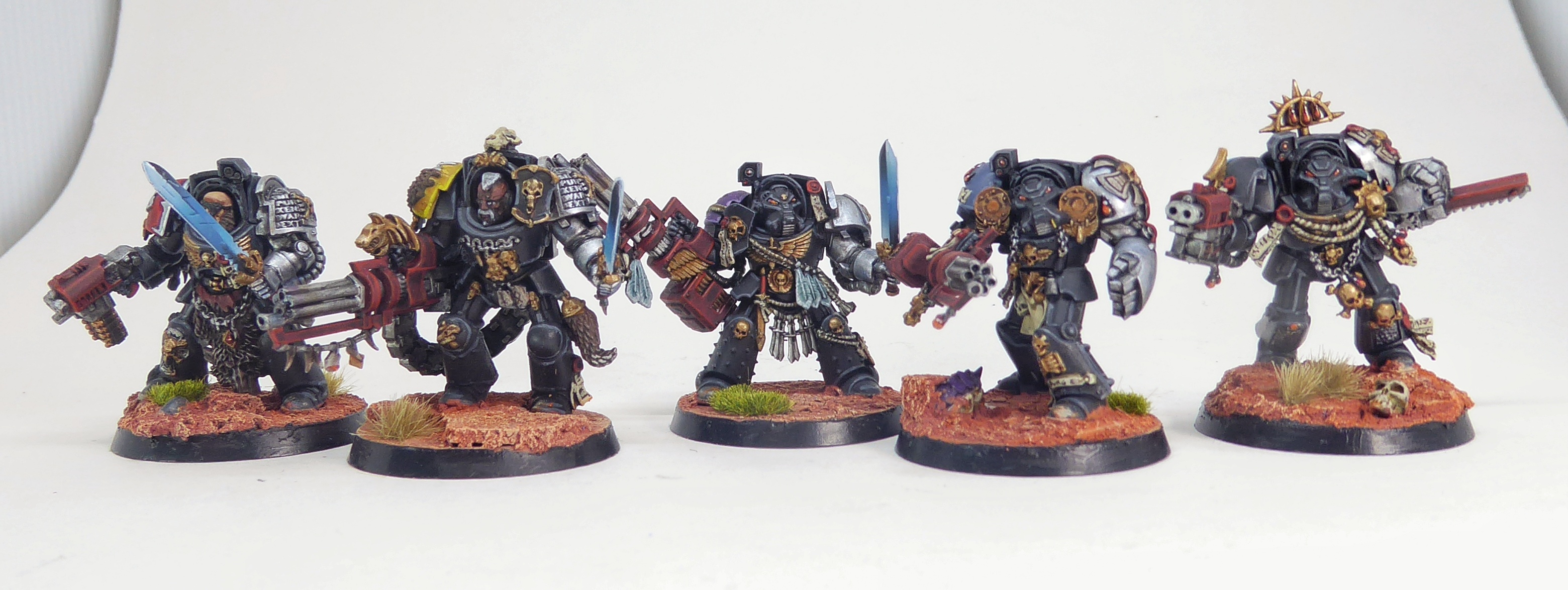
Deathwatch get alternative datasheets for Veterans (a sort of catch-all for the core Marine units), Terminators and Bikers. All get some extra options over their regular brethren, making them look pretty tasty.
Veterans continue their tradition from previous editions of being able to take all sorts of stuff, though some of it has been simplified – all combi-weapons are now a single Long Vigil Ranged Weapon profile, and all power weapons become Long Vigil Melee Weapons. The melee weapon is a perfectly serviceable profile but the ranged weapon is very skippable, as these feel like they mostly want to be all-rounders to sit on your backline or in a position you don’t want to commit a full Kill Team to and either inflict some chip damage or bully something off an objective. To that end, I think the default loadout here probably ends up as two infernus heavy bolters, two heavy thunder hammers and a xenophase blade/shield sergeant – that gives you some real value at range (especially into Xenos) and a genuinely scary melee setup with lots of high-roll potential from Devastating Wounds. Extremely nasty as Battleline goes, let’s hope the price is right.
Terminators are also wild, literally just being regular Terminators (teleport homer and all) except that you can take three heavy weapons (including the option of plasma cannons) and mix and match melee in. You know what that means if you’ve played any late 9th – three heavy weapon guys, two hammer/shield guys, job’s a good’un (though they have at least successfully worded cyclone launchers so that you can’t take hammer/shield as well now). Realistically, those heavy weapons are pretty much always assault cannons right now – the combination of Hellfire Rounds and Devastating Wounds is so incredible that you basically want to cram as much as possible of it into every Deathwatch list. The only thing holding Terminators back is that you can also just put those three Assault Cannons into a Proteus team (and you’re gonna). [not any more, see note at the start] After the change to Hellfire Rounds, there’s a lot more call for considering cyclone launchers, which are also great!
Finally, bikers – like regular bikers, but you can take a long vigil melee weapon each for a bit of punch. Sure – unlikely to make them a centrepiece or anything, but better than regular ones.
Kill Teams
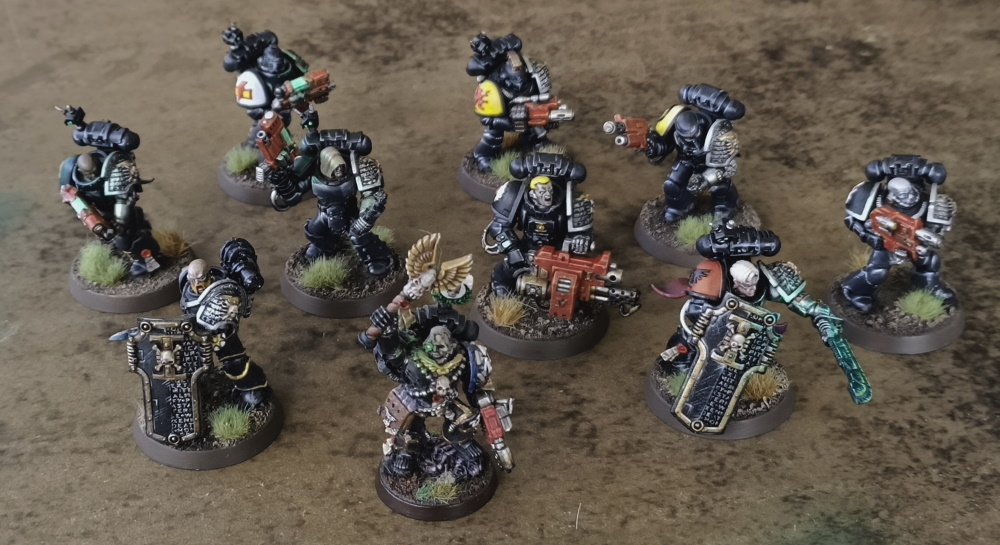
Ok kids, here’s the good stuff – Proteus and Indomitor Kill Teams look incredible and should be the absolute anchor of Deathwatch lists. Something to note for both of these is that some weapon options (e.g. heavy weapons for Veterans in a Proteus) are still provided as “for every five models in this unit” – so if you have a ten model unit, you can use the option twice, even if only half the models in the unit are Veterans.
Proteus Teams combine Veterans with the option to add up to four Terminators, Four VanVets or two Bikers. The configuration you’re going to want for these is going to be something in the region of:
- Three Veterans with heavy weapons (probably the heavy bolters)
- Two Veterans with shields and long vigil weapons.
- Three Terminators with
assault cannons[not any more, see note at the start] Take Cyclones now. - One hammer/shield Terminator.
- One Biker
This gives you a unit that, when you pop Hellfire Rounds, eradicates pretty much any infantry unit in the game, no questions asked, especially if you Oath them. Assault cannons with Anti-Infantry 2+ are absolute nightmares,[not any more, see note at the start] and adding heavy bolters as well certainly isn’t bad, and also gives the unit some nasty overwatch capabilities from the heavy flamer profile. You’re going to have some sort of character in here (pick and choose from Watch Master, regular Captain or Artemis), so you’re starting at 11 models, meaning you want to drop wounds on shield Veterans first to get yourself to majority T5, after which you’re a huge pain to chew through as well. You’re also handy in a fight, four Terminators and a character is no joke. Capping it all off, Proteus Doctrines gives you +1 to hit when you target a unit that’s not below Half Strength, making them particularly good when alpha striking your opponent’s best stuff. Take two in every list, erase half your opponent’s army from existence the first time you shoot, simple.
Indomitor Kill Teams look like the other real standout because they’ve got plenty of dakka and they’re hefty. You can build these as follows;
- Three Heavy ints with regular bolters.
- Two Heavy ints with heavy bolters
- Two Aggressors
- Two Inceptors
- One Eradicator with multi-melta
I’m slightly undecided on weapon options for the Aggressors and Inceptors, though am leaning towards it probably just being the bolt options for both for volume. To this recipe, I’d add the fancy new Apothecary Biologis from the Leviathan box, giving the whole unit Lethal Hits, carrying the Beacon Angelis and making it so that if you punch something off an objective, your opponent is basically never getting it back until this unit dies. As the opponent tries to do that, this unit gets even nastier – Indomitor Doctrine means that as soon as a model dies the unit gets +1 to hit, and once they’re below Half Strength they get +1 to wound as well, so when you’re down to the heavy bolter ints, Eradicator and an Inceptor you throw out a bunch of nasty, reliable shots. Rapid Insert these somewhere they can cause a problem, ruin the opponent’s day from there.
Next up we have the finesse option of the bunch, the Spectrus team. I’m much higher on these than Shane, as there’s some neat tricks you can pull with them, but it’s definitely fair to say that they need to be considerably cheaper than the two teams above for that to be enough to include them. The relevant details of these is that they have Scouts 6”, helpful for early pressure application, can add two each of Eliminators and Suppressors, and if they’re more than 6” from any enemy units at the end of the opponent’s Fight Phase, can jump into Strategic Reserves then arrive in your turn for free. That gives them quite a bit of flexibility on the table, attached to decent chip damage, and that might be something that’s worth it? Notably, they’re a far more interesting place to put most of the Phobos characters than any of the regular Phobos squads, and both the Phobos Lieutenant (until they remember to errata in “can’t charge” to his Fire and Fade) and Phobos Librarian have some extremely strong interactions with what you’ve got here. Probably you end up wanting to spend points elsewhere, but I think there’s some tech options.
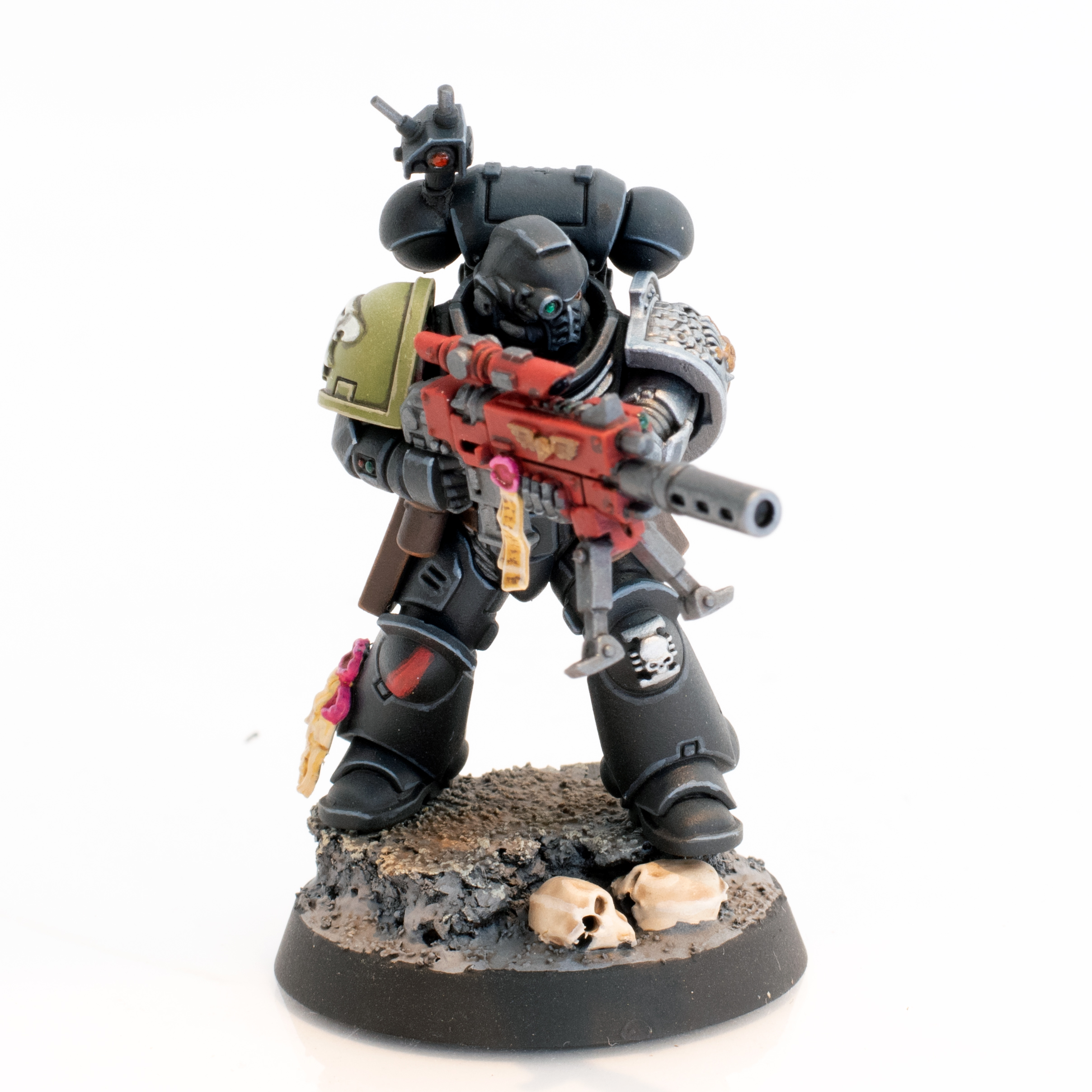
Finally, the weakest of the bunch is probably the Fortis Team, just because there’s far less you can do to push it to terrifying degrees, and because Fortis Doctrine is the worst of the bunch, giving you a boost against stuff that’s below Half Strength, which is not what you want on an alpha unit. Probably still decent, points allowing, but unless there’s an absolutely incredible points disparity it’s hard to see optimised lists wanting these over the juicy stuff.
Other Units
Deathwatch do, of course, have access to the majority of the Marine roster, plus one more unit of their own. Their special toy is the Corvus Blackstar, a Hover plane that can transport a full Kill Team, and is pretty durable. Honestly the stats on this are pretty great, and it has the right combination of abilities to do its job well, but because Teleportarium exists you don’t need it. Could end up as a flex choice though, and I think the important thing here is that putting one on the table and using it is now going to be fun and satisfying in a casual game, it won’t feel like an albatross around your neck.
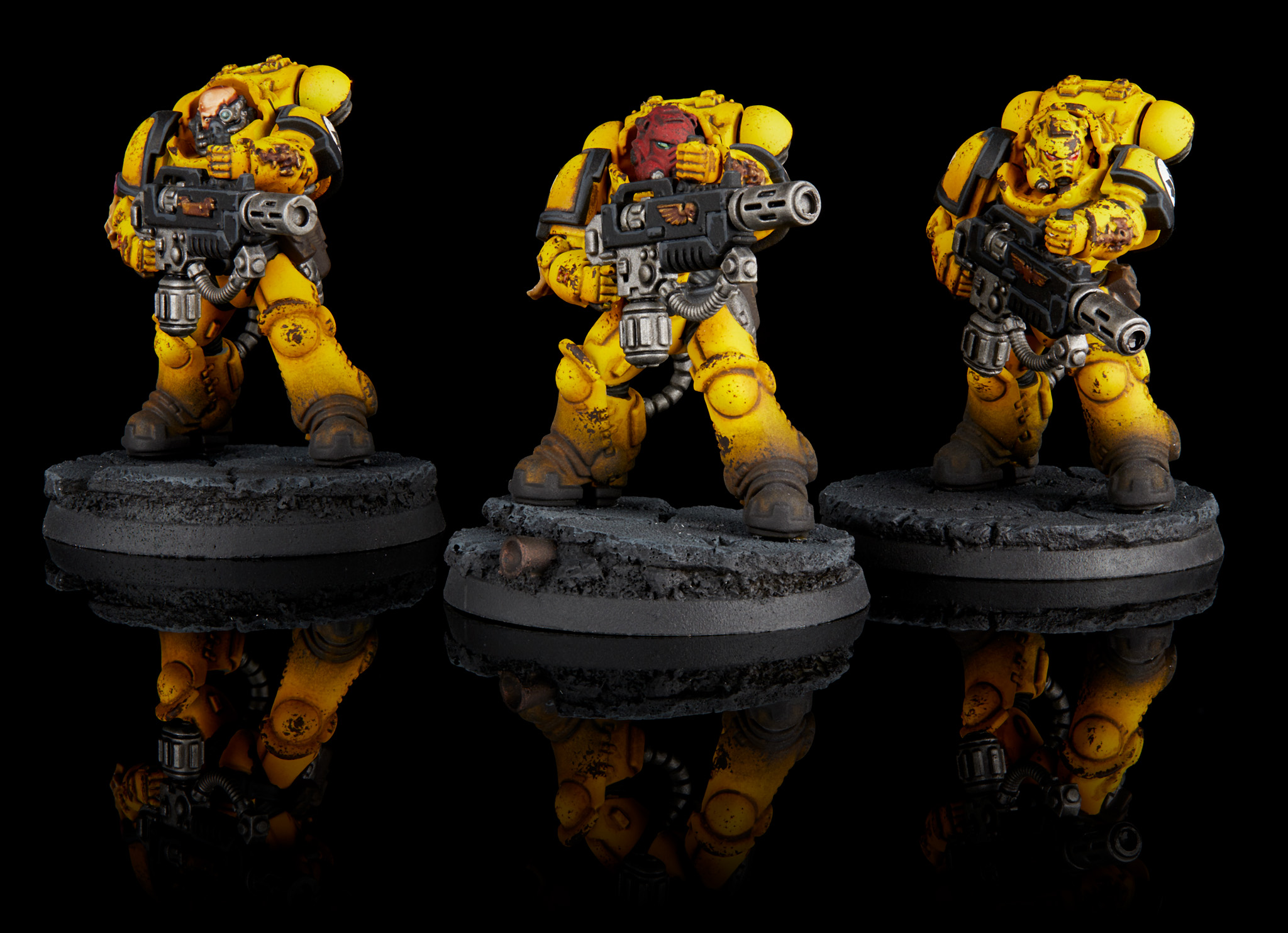
Moving on to the rest of the Marine roster, your key choices are essentially Eradicators, Infiltrators, Desolation Squads and Sternguard. The only chink in the armour of the nightmare Kill Teams is a slight weakness into vehicle-heavy lists, so bringing some Eradicators (extremely good with Teleportarium or the Beacon) is a great way to mitigate that, and you can use Kraken Rounds to get within melta range out of deep strike. Infiltrators remain an incredibly good flexible utility/objective play unit. Finally, Desolation Squads with any of the special ammunition Stratagems, and maybe Sustained Hits 1 as a treat, are deeply upsetting. Finally, you see all those thoughts above about how good Hellfire Rounds is with Devastating Wounds? Remember how Sternguard provide the most Devastating Wounds shots available to any Marine unit? And get to shoot again if they kill a unit once per battle. Yeah uh, maybe put ten in a Drop Pod and make some friends. [not any more, see note at the start. Thank goodness].
Other units are also, presumably, available. They are not even slightly required.
Wrap Up
Deathwatch have one of the most powerful sets of tools of any Index we’ve looked at so far, and look like serious contenders for best Marines. Quite honestly, some of what’s here is alarmingly powerful, and if the pricing on some of this stuff is too aggressive, you’re potentially looking at one of the top-tier Indexes out of the gate. Putting a marker down now – I do not think we will get to the end of the year without Hellfire Rounds getting an exclusion for weapons with Devastating Wounds, but even after that there’s a tonne of great stuff to play with here. Deathwatch players rejoice, Xenos players cower.
